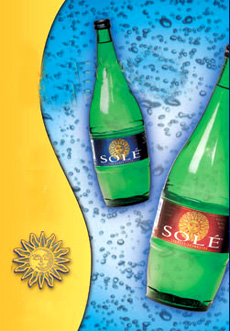
 Mineral water, bottled from underground springs and aquifers, continues to grow in popularity. Photo courtesy Sole. Mineral water, bottled from underground springs and aquifers, continues to grow in popularity. Photo courtesy Sole.
October 2005
Last Updated April 2013 |
 |
What Are The Types Of Water?
Here They Are: Water Terms & Definitions
Page 2: Letters F ~ M
If your question is, “What are the types of water,” this glossary holds the answer. On this page, you’ll find water terms such as groundwater, hard water and mineral water. If you enjoy this Water Glossary, we have a food glossary for almost every category of food.
Click on s letter to go to the appropriate glossary section.
a b c d e f g h i j k l m n o p q r s t u v w x y z
This glossary is protected by copyright and cannot be reproduced in whole or in part. You are welcome to link to it.
|
FINE PRINT
More than a few products called “mineral water” are not natural mineral water. They can be tap water that has been distilled, with or without minerals added in. The two largest brands of water in the U.S., Aquafina and Dasani (produced by Coke and Pepsi bottlers) fall into this category. It is important to read the fine print on labels to know what you are buying.
FINE WATER
A term referring to single origin bottled mineral waters, as opposed to distilled bottle waters (e.g. Dasani, Aquafina, Ethos).
FIZZY WATER
Another term for carbonated water.
FINEWATERS BALANCE
A guide developed by Michael Mascha of Finewaters.com to classify the different kinds of mineral water. It is divided among Still and four degrees of intensity of sparkling water (from right to left): Effervescent, Light, Classic and Bold.
 Examples include: Examples include:
- Still: Evian, Fiji, Poland Spring, Spa, Trinity, Vittel, Volvic
- Effervescent: Badoit, Ferrarelle, Gleneagles, Sanfaustino, Voss
- Light: Daggio, Galvanina, Ramlosa, Sole
- Classic: Apollinaris, Fiuggi, Gerolsteiner, Lurisia, San Pellegrino
- Bold: Perrier, Saratoga Springs, Tipperary, Ty Nant
GROUNDWATER
Water flowing within aquifers below the water table. The water flows through the pore spaces in unconsolidated sediments and the fractures of rocks. Groundwater is replenished from precipitation, streams and rivers that seeps into the aquifer, and eventually flows to, the surface naturally, generally emerging at springs.It is estimated that the volume of groundwater is fifty times that of surface freshwater; the icecaps and glaciers are the only larger reservoir of fresh water on earth.
HARDNESS or HARD WATER
Hardness refers to the presence of calcium and magnesium in the water, i.e., how calcareous the water is. Using the European Community standards measured in French grades (F), waters with a hardness of less than 30 F, are considered “soft,” i.e. moderately calcareous. Numerous epidemiology studies in many countries have concluded that populations consuming hard water containing calcium and/or magnesium have a lower risk of certain types of cardiovascular disease. A 2004 committee report to the World Health Organization concluded that the benefits hypothesis was probably valid, especially for magnesium in drinking water, but a more detailed scientific assessment is necessary.
HIGH MINERAL CONTENT
Mineral water with Total Dissolved Solids greater than 1,500 parts per million (ppm).
LOW MINERAL CONTENT
Mineral water with Total Dissolved Solids below 500 parts per million (ppm).
MINERAL-ENHANCED WATER or POLISHED WATER
A water whose chemistry is artificially altered; a processed water, rather than a natural water.
MINERALS
Minerals are natural compounds formed through geological processes. Minerals range in composition from pure elements and simple salts to very complex silicates. Minerals commonly found in water are calcium, magnesium, phosphorus, potassium, sodium, sulfate (the salt of sulphur) and other sulphur compounds, and trace elements such as iron, iodine, copper, fluoride or zinc. Minerals provide nutritional value and can have therapeutic value. In addition to minerals, effervescent waters contain gases, including carbon dioxide.
MINERAL WATER
Spring water that has a higher mineral content, no less than 250 parts per million of Total Dissolved Solids (TDS) that alter its taste or give it therapeutic value. Mineral water is distinguishable by its specific content of these trace elements and minerals, giving each water a unique taste. Salts, sulfur compounds, and gases are among the substances that can be dissolved in the water. Mineral water can be prepared or can occur naturally, and can be still or effervescent (prepared or natural). There are over 2,800 brands of mineral water available commercially worldwide, and the industry generates an estimated $22 billion in sales. Examples include Apollinaris, Evian, Perrier and San Pellegrino. See also Natural Water and Source.
MOUTHFEEL
The tactile sensation of food (including beverages) in the mouth.
MUNICIPAL WATER
Municipal water, or tap water, is processed and monitored by governing agencies with the same or greater scrutiny as bottled water. Municipal water supplies are supervised closely to adhere to EPA rules for contaminants. The water is first disinfected with chlorine. Fluoride is added for cavity protection, as well as phosphate, which is used to help isolate iron and manganese, which can corrode pipes without the addition of phosphate. While bottled water may have a better scent and flavor, it is no better or worse safety-wise than tap.
Go To Page 3: Water Terms Letter N ~ P
Return To The Article Index Above

|





 Examples include:
Examples include: